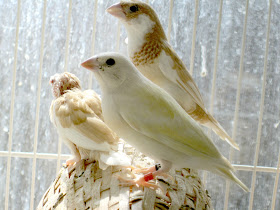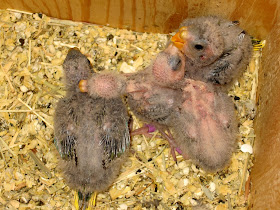Here are the 2 gouldian babies from the second clutch of the pair who didn't sit well for the 1st clutch then tossed the 1st baby from their 2nd clutch. These guys are so stuffed by their society fosters, they can't even roll over anymore. Looks to be 1 yellow and 1 normal/?dilute.
Here is one of the foster mothers - a pied fawn society.
Here are their older siblings from the 1st clutch. Doing well and growing feathers already. Very well fed by their foster parents from the looks of their full crops. They are definitely both yellow.
Here's another society foster - a pied fawn male.
This is 1 of my handicapped societies - a crested pied fawn male. It's hard to tell, but he lost his right foot shortly after weaning by catching it between cage bars. The foot broke off essentially. I feared for his life. All I was able to do was to put some triple antibiotic cream and try to stablize the fracture with a bandaid. The foot eventually dried up and fell off. He has done amazingly well. Most of the time I can't even tell he lacks a foot. He too helps with feeding babies - societies or fostered gouldians.
One of my creasted pied fawn society males brooding some babies - actually society babies instead of fostered gouldians in this nest. Not sure if the last eggs will hatch or not. There looks to be at least 3 hatched babies so far.
Here he is trying to reposition one of the unhatched eggs.
These are my 2 young male chocolate self split to creamino societies.
Here's the creamino society hen - I love how the creaminos look. I have her with the 2 chocolate self split to creamino males - so far no fertile eggs yet. Hopefully the young boys will start to be more productive soon.
I finally took some pictures of my red factor canaries. They were not color-fed by their previous owner, so are gaining color as they molt. I'm using a more dilute solution of Cathaxantine and Bogena Intensief trying to avoid any liver toxicity, so they are turning out a little more orange than intense red. Of course, they may not be the intensive lipochrome types to begin with. This is the younger bird, who, the previous owner thought may be a hen - I'm thinking it's a male, but he hasn't sang yet; not sure if it's because he is still molting or he's more subordinate to the other male or he is a she.
Here is the older male. I have heard him sing beautifully; hopefully more once he finishes molting.
This is Mao, my sweet boy - being good after I told him not to go into my aviary even though the door is open.
 |
| Yellow headed purple breasted green split to blue backed male gouldian |
 |
| YH PB GB/BB on left, RH PB BB male gouldian on right |
 |
| RH WB GB/BB hen gouldian |
 |
| BH PB GB hen gouldian |
 |
| BH PB YB hen, BH WB YB hen, RH PB BB male gouldians |



From left lower to right top, RH PB YB hen, RH LB YB/BB male, RH PB BB hen gouldians.
This is Sunshine, another young yellow turquoisine hen that I acquired to be the mate for Turkey, the male normal split to yellow turquoisine. She appears to be red bellied.
 |
| Sunshine from the back. |



























































